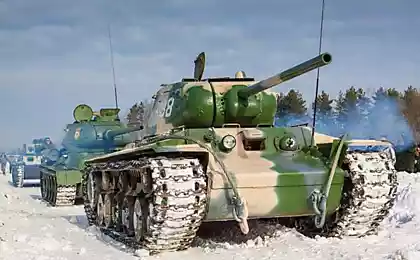1080
State Aviation Museum of Ukraine!
In search of interesting places on the Internet Tools in Kiev and Kiev region, I came across a museum whose existence, having lived all my life in Kiev did not know ... I decided to go see the pictures do ...
Photos are so many try to choose interesting exhibits ... Please do not break when I finish I will write ...
And so ...
Spy plane "Anatra-Anasal"
The scout and light bomber "Anatra-Anasal" went down in history as the first production aircraft, which was manufactured in Ukraine. It was created and produced the first of the former Russian Empire specialized aircraft plant in Odessa, which was owned by businessman Arthur Anatra. The device at the time of the classical scheme biplane first flew on July 27, 1916.
The crew consisted of two people - a pilot and an observer-arrow armed with machine guns. He also, if necessary, manually removed the bombs on the enemy.
Serial production of "Anatra" began in a stormy 1917, so his fate was Determined adventure. Quite a point that he had to make war under the flag ... as many as six states - Russia, the Ukrainian People's Republic, Austria-Hungary, Austria, Czechoslovakia and Hungary. And that's not taking into account the use of the White and Red armies.

"Yak"
Symbolic "Yak" in the 70s was shot in the movie "go to fight some old" - probably the best and most truthful cinematic about pilots in the war. According to the story, it "flew" the protagonist of the film, the commander of the "Singing Squadron", whose role is performed Leonid Bykov. Perhaps it is because this exhibit and is not an exact replica of a specific aircraft: every veteran who has ever fought in, "yak", will find in it the features of "their" machines - the Yak-1, Yak-3 and Yak-9.
Yakovlev fighters were the massive war machines of Soviet aviation during the Great Patriotic War - a total of almost 36,000 built. On the "yak" fought as French pilots of the regiment "Normandie-Niemen" and Polish pilots of the regiment "Warsaw".
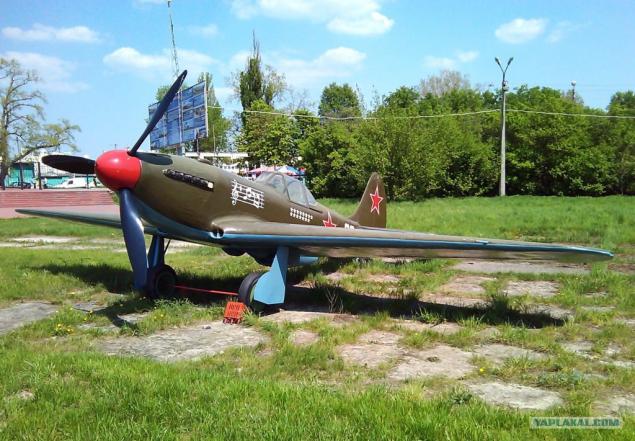
Aerobatic Yak-18PM
Yak-18PM is a further development of the design created in 1946 training aircraft Yak-18. Option PM (ie "aerobatic modified") first took the air in December 1965, was created exclusively for the athletes - masters of aerobatics of the highest class. The machine had forced the engine and significantly improved aerobatic properties that enabled the Soviet national team in 1966 to win the championship at the IV World Championships in aerobatics. Yak-18PM - it's quite a rare artifact, because all were built only 30 such aircraft. Several of them flew to Kiev club DOSAAF.
First flight: December 1965

Aerobatic Yak-18PM

Fighter-bombers MiG-23BM
MiG-23 - the third generation of the car and one of the first Soviet combat aircraft with a wing changeable geometry. Such an improved wing flight and tactical characteristics as enabled to connect to high speed long range, maneuverability and good take-off and landing characteristics. The collection includes three machines from a rather large "family" - the front-line MiG-23ML, and two established on the basis of its fighter-bomber - the MiG-23BM and MiG-27K. The latter was the most difficult in its class avionics and a wide range of high-precision weapons.
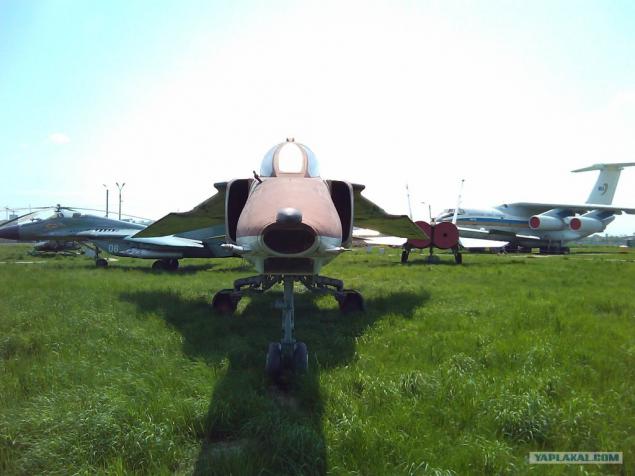
Regional passenger aircraft Tu-134A
The first Soviet short-haul passenger jet Tu-134 has created the most popular "creative method" in Tupolev - the maximum use of units from the previous design.
To do this, all the dimensions of the Tu-104 reduced by 20%. However, the first version of the machine was unsuccessful - the plane appeared inconvenient both for passengers and for staff. Interestingly, the creation of a successful model of Tupolev inspired Nikita Khrushchev: during a visit to France, he flew on a plane "Caravel", and placing the engines in the rear he liked - the noise in the cabin is almost not felt.
Serial production of Tu-134 took place in Kharkov, too - in the years 1966-70 was built 78 machines. Tu-134 was the first Soviet aircraft certified according to international standards of airworthiness. He still flies on many airlines in Ukraine and CIS.

Mid-range passenger aircraft Tu-154
Mid-range aircraft of the second generation of the Tu-154 created in the late 60s. It incorporates the best qualities of the first generation of aircraft: the speed of the Tu-104, the range and efficiency of the IL-18, and the comfort and landing characteristics of the An-10.
Thanks to the good aerodynamics and new engines, these machines for a long time were the most efficient in the "Aeroflot", so it is quite a lively were exported. In the 80 years of the Tu-154 was called "the workhorse of Eastern European airports." More than half of Aeroflot's traffic carried these machines. They were taken on board up to 176 passengers and transported them to a distance of 3900 km. A maximum range (with 164 passengers) reached 5,200 km.
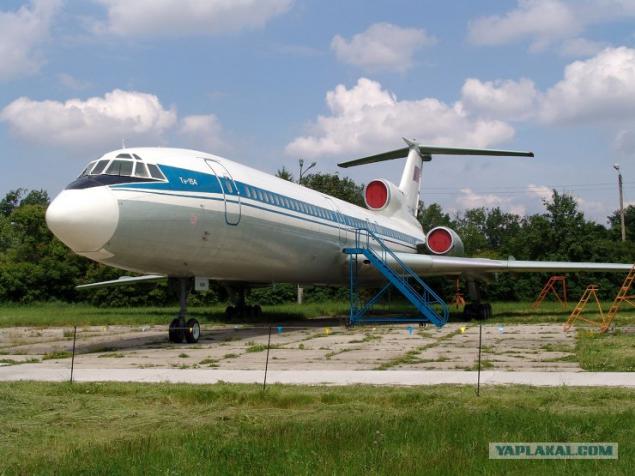
Mid-range passenger aircraft Tu-154
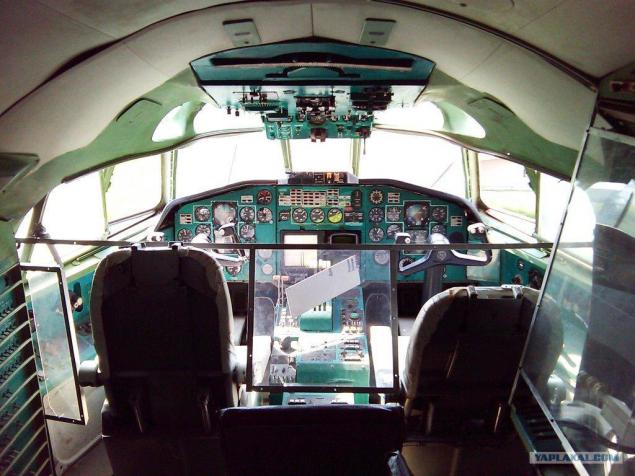
Mid-range passenger aircraft Tu-154

ASW seaplane Beriev Be-6 (KL)
Crew: 8 people.
Engines: AL-73, 2 x 2400 hp
Take-off weight (max.), Kg: 28850
Speed: max., Km / h. - 405
Service ceiling: 6100 m
Flight distance: 5000 kilometers
Armament: 5 23 mm guns, conventional and depth charges, naval mines weighing up to 3000 kg
Series production: 1952-1957 g,
Issued 123 copies

Heavy transport helicopter Mi-26
Heavy Duty Mi-26 was created in the late 70s, and adopted the title of "the most powerful helicopter of the world" from the above-mentioned MI-6. It is capable of carrying up to 20 tons of cargo at speeds up to 300 km per hour. These powerful machines are armed with only two states - Ukraine and Russia. Museum instance carries white camouflage as a memory on the participation of Ukrainian aviators in peacekeeping operations under the auspices of the UN. It really is huge like most ...

Multipurpose helicopter Mi-8Mt
Multi-purpose Mi-8 helicopter is the most common "moderate" class in the world - since 1965 has produced more than 11 thousand of these machines, and production continues to this day. It flies on almost every continent, it is used as a military (in the transport and dispatch and transport versions) and a civilian. The museum presents two versions of this machine - a civilian Mi-8AO and military Mi-8T.

Attack helicopters Mi-24D
The impact of the Mi-24 - a "flying infantry fighting vehicle." The helicopter is not only powerful weapons and armor, but is able to take aboard up to eight shooters. Marines can fire in flight through the cabin windows. The crew consists of a pilot and a weapons systems operator. Under the wings of eight hardpoints machine is capable of carrying both conventional weapons (bombs and rockets blocks), and precision-guided anti-tank missiles. These are formidable fighting machines in the armies of 35 countries, including five members of NATO!

Multipurpose helicopter Mi-4
Total in 1952-66 years. released 3307 Mi-4 (all models) in the USSR (of which over 700 were exported to 34 countries of the world), and 545 - in the 1956-79 biennium. PRC

Multipurpose helicopter Mi-4
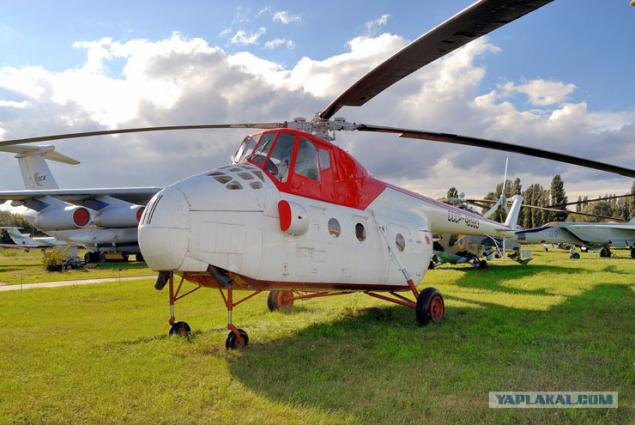
Light multipurpose helicopter Mi-2
Light multipurpose helicopter Mi-2 was created in the early 60s. The design is typical for machines Mile - a classic single-rotor with tail rotor and two turbine engines. It is widely used in the armed forces (as coherent and transport and sanitary) and civil aviation (both passenger and agricultural). However, it is most known as a training (for flight schools) and training (DOSAAF) - almost all helicopter pilots learned to fly on it. Serial production was transferred to Poland, where the plant "Shvidnik" from 1965 to 1992 released 5400 Mi-2 on all models. Modernized model named "Falcon" is issued to the army and the Ministry of Emergency Situations still.
First flight: September 22, 1961
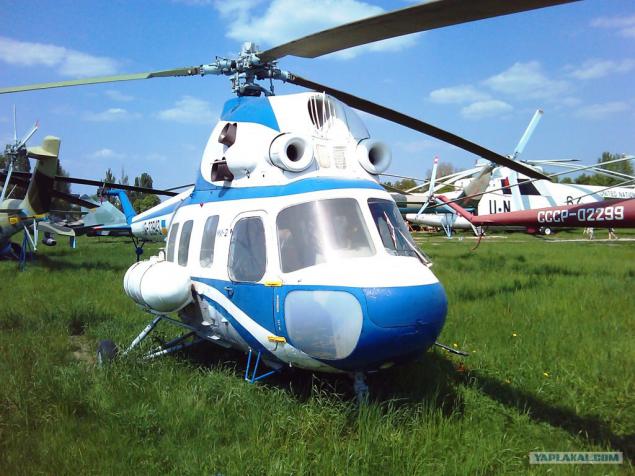
Light multipurpose helicopter Mi-1M
Flight range: maximum - 450 km, normal - 360 km
Series production: 1957-65 years. Total in 1949-65 years. released in 2698 Mi-1 on all models, including 1683 - in Poland WSK "Swidnik"

Heavy transport helicopter Mi-6A
Heavy transport Mi-6 first flew in 1957 and up to the mid-70s was the most powerful helicopter in the world. He was capable of carrying loads of up to 12 tons, or up to 90 people or two landing light self-propelled gun. An interesting design feature of the machine is the presence of the wing, which made it possible not only to take off vertically, and a plane - with a running start.
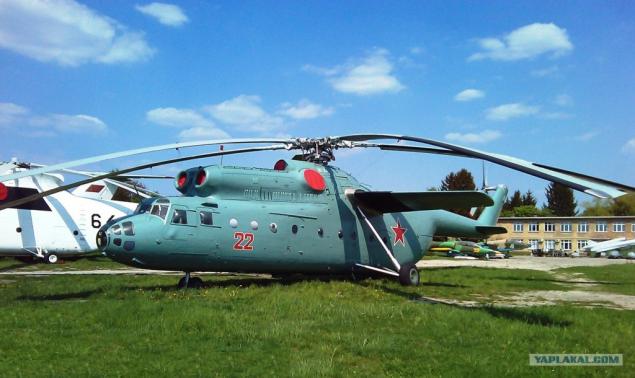
Far antisubmarine aircraft Tu-142MZ
Antisubmarine aircraft long-range Tu-142MZ was the biggest not only in the Soviet naval aviation, but in the world: its wingspan - almost 50 meters and the total capacity of the four engines - 60 thousand horsepower! It is designed to find and destroy submarines with nuclear missiles on the world's oceans.
The advent of submarines with nuclear missiles made to develop means for their search and destroy. The most versatile and mobile of them is the aircraft equipped with special system for detection and destruction.
The development of the first Soviet long-range anti-submarine complex began in the USSR in the early 60s on the basis of reconnaissance aircraft Tu-95RTS.
Experimental instance first flew on June 18, 1968. In December 1972, the aircraft, which received index Tu-142 was adopted. Serial production started at the aircraft factory in Kuibyshev (now Samara), and since 1975 its production was moved to Taganrog.
The structure of the complex consisted of anti-search and sighting system (PPS) "Berkut-95", the search gidroakkusticheskie buoys, which were developed in the Kiev scientific research institute "Gidropribor" and Munitions: anti-submarine torpedoes, depth charges and naval mines.
System "eagle" detect submarines by four channels: gidroakkusticheskim (during turn on depth), magnetic and thermal (at a shallow depth) and Radar (sea surface). However, the sensitivity of its sensors was insufficient, so in 1975, was established modernized version of the Tu-142M s PPP "Kite". Eight of these machines under the symbol TU-142 M-E (export) in 1986 were delivered to the Indian Navy.
The most modern version of the machine is the Tu-142MZ, made its first flight in April 1985. New PPS "district" allowed to raise the combat efficiency of the complex 2-2.5 times. It was adopted in 1993, although production began in 1990. However, for economic reasons, the production stopped in 1994, releasing only 18 machines.
The armament of the Tu-142M and the Ministry of Health also includes anti-missile ACR-2 and ACR-3.
In 2001, the Air Force Northern and Pacific Fleet had a total of 55 aircraft, with two thirds of them were mothballed.
To communicate with submarines on the basis of Tu-142MZ in the early '90s was built aircraft transponder Tu-142MR equipped with long-wave radio. Built 10 machines, which are operated in the North and the Pacific Fleet.
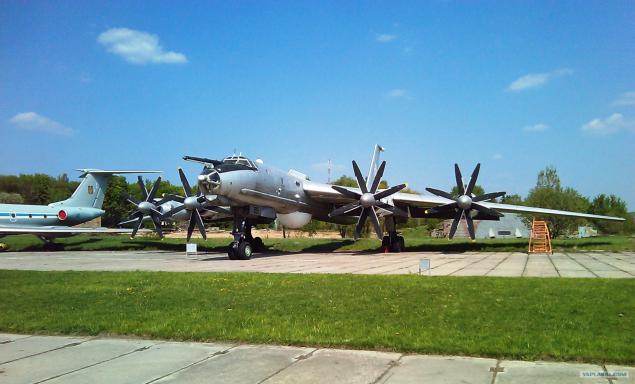
Far antisubmarine aircraft Tu-142MZ
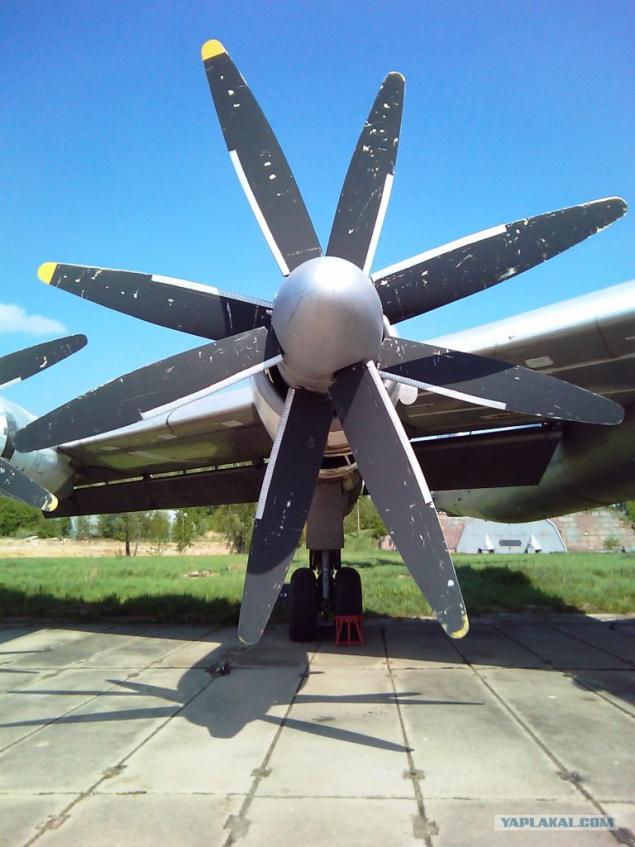
The plane An-71 RLND
Aviation Complex long-range radar guidance.

Engine
Posted in [mergetime] 1336335188 [/ mergetime]
On the territory there are many other exhibits and airplane graveyard but I did not go there because I was a girl ... leave for later)) Thank you all it's ...
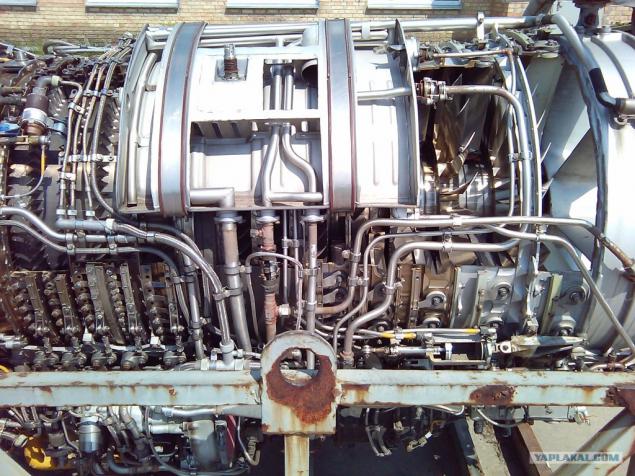
Source:
Photos are so many try to choose interesting exhibits ... Please do not break when I finish I will write ...
And so ...
Spy plane "Anatra-Anasal"
The scout and light bomber "Anatra-Anasal" went down in history as the first production aircraft, which was manufactured in Ukraine. It was created and produced the first of the former Russian Empire specialized aircraft plant in Odessa, which was owned by businessman Arthur Anatra. The device at the time of the classical scheme biplane first flew on July 27, 1916.
The crew consisted of two people - a pilot and an observer-arrow armed with machine guns. He also, if necessary, manually removed the bombs on the enemy.
Serial production of "Anatra" began in a stormy 1917, so his fate was Determined adventure. Quite a point that he had to make war under the flag ... as many as six states - Russia, the Ukrainian People's Republic, Austria-Hungary, Austria, Czechoslovakia and Hungary. And that's not taking into account the use of the White and Red armies.

"Yak"
Symbolic "Yak" in the 70s was shot in the movie "go to fight some old" - probably the best and most truthful cinematic about pilots in the war. According to the story, it "flew" the protagonist of the film, the commander of the "Singing Squadron", whose role is performed Leonid Bykov. Perhaps it is because this exhibit and is not an exact replica of a specific aircraft: every veteran who has ever fought in, "yak", will find in it the features of "their" machines - the Yak-1, Yak-3 and Yak-9.
Yakovlev fighters were the massive war machines of Soviet aviation during the Great Patriotic War - a total of almost 36,000 built. On the "yak" fought as French pilots of the regiment "Normandie-Niemen" and Polish pilots of the regiment "Warsaw".

Aerobatic Yak-18PM
Yak-18PM is a further development of the design created in 1946 training aircraft Yak-18. Option PM (ie "aerobatic modified") first took the air in December 1965, was created exclusively for the athletes - masters of aerobatics of the highest class. The machine had forced the engine and significantly improved aerobatic properties that enabled the Soviet national team in 1966 to win the championship at the IV World Championships in aerobatics. Yak-18PM - it's quite a rare artifact, because all were built only 30 such aircraft. Several of them flew to Kiev club DOSAAF.
First flight: December 1965

Aerobatic Yak-18PM

Fighter-bombers MiG-23BM
MiG-23 - the third generation of the car and one of the first Soviet combat aircraft with a wing changeable geometry. Such an improved wing flight and tactical characteristics as enabled to connect to high speed long range, maneuverability and good take-off and landing characteristics. The collection includes three machines from a rather large "family" - the front-line MiG-23ML, and two established on the basis of its fighter-bomber - the MiG-23BM and MiG-27K. The latter was the most difficult in its class avionics and a wide range of high-precision weapons.

Regional passenger aircraft Tu-134A
The first Soviet short-haul passenger jet Tu-134 has created the most popular "creative method" in Tupolev - the maximum use of units from the previous design.
To do this, all the dimensions of the Tu-104 reduced by 20%. However, the first version of the machine was unsuccessful - the plane appeared inconvenient both for passengers and for staff. Interestingly, the creation of a successful model of Tupolev inspired Nikita Khrushchev: during a visit to France, he flew on a plane "Caravel", and placing the engines in the rear he liked - the noise in the cabin is almost not felt.
Serial production of Tu-134 took place in Kharkov, too - in the years 1966-70 was built 78 machines. Tu-134 was the first Soviet aircraft certified according to international standards of airworthiness. He still flies on many airlines in Ukraine and CIS.

Mid-range passenger aircraft Tu-154
Mid-range aircraft of the second generation of the Tu-154 created in the late 60s. It incorporates the best qualities of the first generation of aircraft: the speed of the Tu-104, the range and efficiency of the IL-18, and the comfort and landing characteristics of the An-10.
Thanks to the good aerodynamics and new engines, these machines for a long time were the most efficient in the "Aeroflot", so it is quite a lively were exported. In the 80 years of the Tu-154 was called "the workhorse of Eastern European airports." More than half of Aeroflot's traffic carried these machines. They were taken on board up to 176 passengers and transported them to a distance of 3900 km. A maximum range (with 164 passengers) reached 5,200 km.

Mid-range passenger aircraft Tu-154

Mid-range passenger aircraft Tu-154

ASW seaplane Beriev Be-6 (KL)
Crew: 8 people.
Engines: AL-73, 2 x 2400 hp
Take-off weight (max.), Kg: 28850
Speed: max., Km / h. - 405
Service ceiling: 6100 m
Flight distance: 5000 kilometers
Armament: 5 23 mm guns, conventional and depth charges, naval mines weighing up to 3000 kg
Series production: 1952-1957 g,
Issued 123 copies

Heavy transport helicopter Mi-26
Heavy Duty Mi-26 was created in the late 70s, and adopted the title of "the most powerful helicopter of the world" from the above-mentioned MI-6. It is capable of carrying up to 20 tons of cargo at speeds up to 300 km per hour. These powerful machines are armed with only two states - Ukraine and Russia. Museum instance carries white camouflage as a memory on the participation of Ukrainian aviators in peacekeeping operations under the auspices of the UN. It really is huge like most ...

Multipurpose helicopter Mi-8Mt
Multi-purpose Mi-8 helicopter is the most common "moderate" class in the world - since 1965 has produced more than 11 thousand of these machines, and production continues to this day. It flies on almost every continent, it is used as a military (in the transport and dispatch and transport versions) and a civilian. The museum presents two versions of this machine - a civilian Mi-8AO and military Mi-8T.

Attack helicopters Mi-24D
The impact of the Mi-24 - a "flying infantry fighting vehicle." The helicopter is not only powerful weapons and armor, but is able to take aboard up to eight shooters. Marines can fire in flight through the cabin windows. The crew consists of a pilot and a weapons systems operator. Under the wings of eight hardpoints machine is capable of carrying both conventional weapons (bombs and rockets blocks), and precision-guided anti-tank missiles. These are formidable fighting machines in the armies of 35 countries, including five members of NATO!

Multipurpose helicopter Mi-4
Total in 1952-66 years. released 3307 Mi-4 (all models) in the USSR (of which over 700 were exported to 34 countries of the world), and 545 - in the 1956-79 biennium. PRC

Multipurpose helicopter Mi-4

Light multipurpose helicopter Mi-2
Light multipurpose helicopter Mi-2 was created in the early 60s. The design is typical for machines Mile - a classic single-rotor with tail rotor and two turbine engines. It is widely used in the armed forces (as coherent and transport and sanitary) and civil aviation (both passenger and agricultural). However, it is most known as a training (for flight schools) and training (DOSAAF) - almost all helicopter pilots learned to fly on it. Serial production was transferred to Poland, where the plant "Shvidnik" from 1965 to 1992 released 5400 Mi-2 on all models. Modernized model named "Falcon" is issued to the army and the Ministry of Emergency Situations still.
First flight: September 22, 1961

Light multipurpose helicopter Mi-1M
Flight range: maximum - 450 km, normal - 360 km
Series production: 1957-65 years. Total in 1949-65 years. released in 2698 Mi-1 on all models, including 1683 - in Poland WSK "Swidnik"

Heavy transport helicopter Mi-6A
Heavy transport Mi-6 first flew in 1957 and up to the mid-70s was the most powerful helicopter in the world. He was capable of carrying loads of up to 12 tons, or up to 90 people or two landing light self-propelled gun. An interesting design feature of the machine is the presence of the wing, which made it possible not only to take off vertically, and a plane - with a running start.

Far antisubmarine aircraft Tu-142MZ
Antisubmarine aircraft long-range Tu-142MZ was the biggest not only in the Soviet naval aviation, but in the world: its wingspan - almost 50 meters and the total capacity of the four engines - 60 thousand horsepower! It is designed to find and destroy submarines with nuclear missiles on the world's oceans.
The advent of submarines with nuclear missiles made to develop means for their search and destroy. The most versatile and mobile of them is the aircraft equipped with special system for detection and destruction.
The development of the first Soviet long-range anti-submarine complex began in the USSR in the early 60s on the basis of reconnaissance aircraft Tu-95RTS.
Experimental instance first flew on June 18, 1968. In December 1972, the aircraft, which received index Tu-142 was adopted. Serial production started at the aircraft factory in Kuibyshev (now Samara), and since 1975 its production was moved to Taganrog.
The structure of the complex consisted of anti-search and sighting system (PPS) "Berkut-95", the search gidroakkusticheskie buoys, which were developed in the Kiev scientific research institute "Gidropribor" and Munitions: anti-submarine torpedoes, depth charges and naval mines.
System "eagle" detect submarines by four channels: gidroakkusticheskim (during turn on depth), magnetic and thermal (at a shallow depth) and Radar (sea surface). However, the sensitivity of its sensors was insufficient, so in 1975, was established modernized version of the Tu-142M s PPP "Kite". Eight of these machines under the symbol TU-142 M-E (export) in 1986 were delivered to the Indian Navy.
The most modern version of the machine is the Tu-142MZ, made its first flight in April 1985. New PPS "district" allowed to raise the combat efficiency of the complex 2-2.5 times. It was adopted in 1993, although production began in 1990. However, for economic reasons, the production stopped in 1994, releasing only 18 machines.
The armament of the Tu-142M and the Ministry of Health also includes anti-missile ACR-2 and ACR-3.
In 2001, the Air Force Northern and Pacific Fleet had a total of 55 aircraft, with two thirds of them were mothballed.
To communicate with submarines on the basis of Tu-142MZ in the early '90s was built aircraft transponder Tu-142MR equipped with long-wave radio. Built 10 machines, which are operated in the North and the Pacific Fleet.

Far antisubmarine aircraft Tu-142MZ

The plane An-71 RLND
Aviation Complex long-range radar guidance.

Engine
Posted in [mergetime] 1336335188 [/ mergetime]
On the territory there are many other exhibits and airplane graveyard but I did not go there because I was a girl ... leave for later)) Thank you all it's ...

Source:













